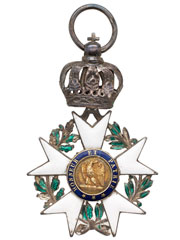
Online Collection
« Prev - 1 of 1 results - Next »
French Legion d'Honneur, 1815 (c)
French medal reputedly recovered from the battlefield of Waterloo.
The Legion of Honour, or in full the National Order of the Legion of Honour (French: Ordre national de la Légion d'honneur) is a French order established by Napoleon Bonaparte on 19 May 1802.
During the French Revolution all French orders of chivalry were abolished and replaced with Weapons of Honour. It was the wish of Napoleon Bonaparte, to create a reward to commend both civilians and soldiers. This wish led to the institution of the Légion d'Honneur, a body of men that was not an order of chivalry, as Napoleon believed France wanted recognition of merit rather than a new system of nobility. The Légion, however, did use the organisation of old French Orders of Chivalry, like the Ordre de Saint-Louis. The badges of the legion bear a resemblance to the Ordre de Saint Louis, which also used a red ribbon.
The design has varied over the years. Those with the first pattern for Napoleon Bonaparte are known as the awards of the First Empire.
The Order is the highest decoration in France and is divided into five degrees: Chevalier (Knight), Officier (Officer), Commandeur (Commander), Grand Officier (Grand Officer), and Grand Croix (Grand Cross). The motto of the order is Honneur et Patrie ('Honour and Fatherland'), and its seat is the Palais de la Legion d'Honneur on the left bank of the River Seine in Paris.
The Legion was loosely patterned after a Roman Legion, with legionaries, officers, commanders, regional 'cohorts' and a grand council. The highest rank was not a grand cross but a grand aigle (great eagle), a rank that wore all the insignia common to grand crosses.
During the fierce fighting at Waterloo it is not surprising that a decoration worn openly might become detached and fall to the ground, to be collected by advancing troops. It is not possible to ascertain to name of the loser of the award since the medals were not named.
NAM Accession Number
NAM. 1983-08-35-1
Copyright/Ownership
National Army Museum, London
Location
National Army Museum, Study collection
Object URL
https://collection.nam.ac.uk/detail.php?acc=1983-08-35-1


